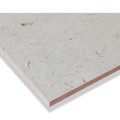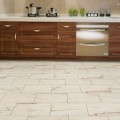Granite Tile Glossary
Although many homeowners tend to associate granite with countertops, granite tiles offer many benefits for floors and walls as well. This durable and distinctive looking natural stone adds color and depth to any surface and can increase a home’s resale value. Check out the below glossary terms to learn more about this decorative natural stone.

Granite tile will give your space a distinctive look and feel. (Agra Granite Tile Pallavas Collection – Steel Gray)
Abrasive Finish: A type of surface finish that’s non-reflective, or flat. This type of finish offers more slip resistance than polished options.
Back Butter: The process of spreading a layer of bonding material to the back of a granite tile with the flat side of a trowel just before installation. This is done to provide optimal coverage of the mortar to the tile before applying it to the substrate.
Bevel: An edge detail of granite tile that creates a curved transition from the top to the sides.
Blend: To arrange granite tile so the natural variations in tone and texture create a visually pleasing field of tile.
Calibrated: Granite tiles are manufactured to ensure thickness is uniform and product dimensions meet the ASTM standards.
Chipping: A broken edge of granite tile. Once installed, granite tile rarely chips, but chipping can occur during installation or or result from poor maintenance.
Cure time: The amount of time a granite tile installation must set before the grout and/or thinset dries and hardens completely.
Diagonal set: The installation of granite tiles at a 45-degree angle to the wall, creating diamonds rather than squares.
Efflorescence: White or gray strip or smudge on the surface of granite caused by salt deposits.
Fabrication: The manufacturing process that produces granite tiles ready for installation. Granite tiles can be cut and shaped in almost limitless ways to meet the design requirements.
Field Tile: The main tile used on a wall or floor. This can contrast with accent or border tiles.
Flamed: A granite tile finish that results in a rough, textured surface that provides slip resistance.
Grain: The patterns and color variations in a granite tile’s surface. The grain changes from one section of stone to the next.
Granite: An igneous rock created under pressure and with extreme heat. Considered one of the most durable varieties of natural stone, Granite tiles come in many colors and patterns. Different surface finishes include polished, honed, and leathered.
Grout: A thin mortar that’s used to fill the joints between granite tiles. For grout joints 1/8” or larger, use sanded grout; for grout joints 1/8” or smaller, use unsanded grout.
Hardness: An important quality of granite stone that makes it less vulnerable to cracking, chipping, staining, and other damage than other natural stone.
Honed: A satin or matte looking finish that helps hides scratches and reflects less light.
Polished: A high-gloss finish on granite that creates maximum reflectivity of light and a shiny appearance.
Porosity: A surface’s vulnerability to moisture penetration. Granite is one of the least porous stones, which means it won’t absorb water or stain easily. Experts still recommend sealing granite to protect the stone from stains.
Running Bond: An offset tile pattern that resembles brick.
Sealant: A topical coating used to protect natural stone and grout from absorbing liquid and becoming stained.
Staining: A blemish on granite due to standing water or other liquids. Granite does not stain easily, but long periods of standing liquids can leave marks.
Thinset: A type of mortar made from cement, fine grain sand, and water retention compounds that’s used to bond granite tile to a substrate.
Trim (molding): Decorative edging applied to a granite tile installation to finish a room or border. Sometimes trim hides spaces between tiles and other flooring materials or between floors and walls.
Wall tile: A thinner form of granite tile intended for installation on walls rather than floors.
Water-cut: Quality granite is cut using a water coolant. Some manufacturers use kerosene as their coolant during the cutting process to reduce costs. Within a couple of years manufacturing, rust marks will appear on kerosene cut granite.
What else would you like to learn about granite tile? Let us know in the comments.
Browse our selection of beautiful Granite Tile here.



